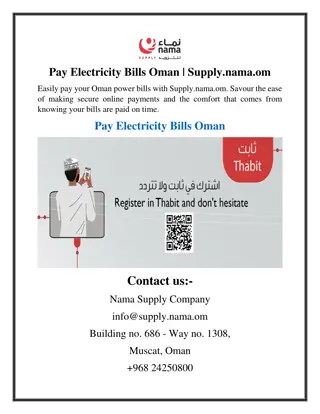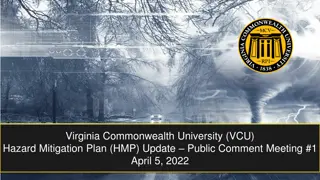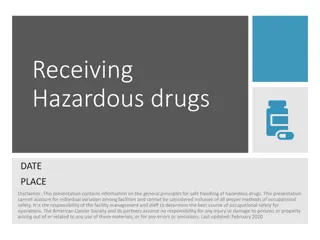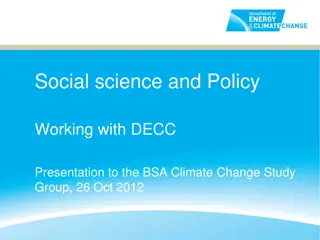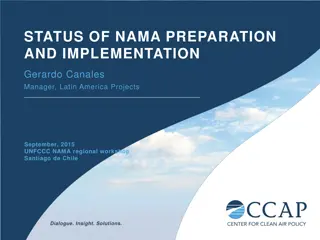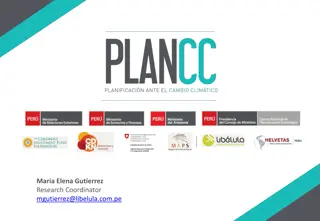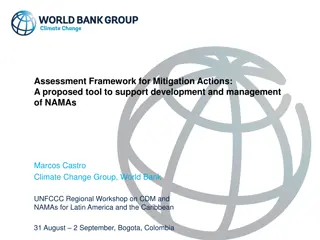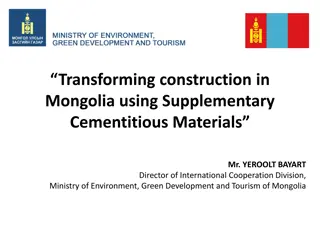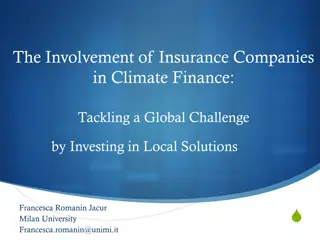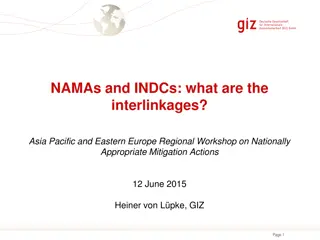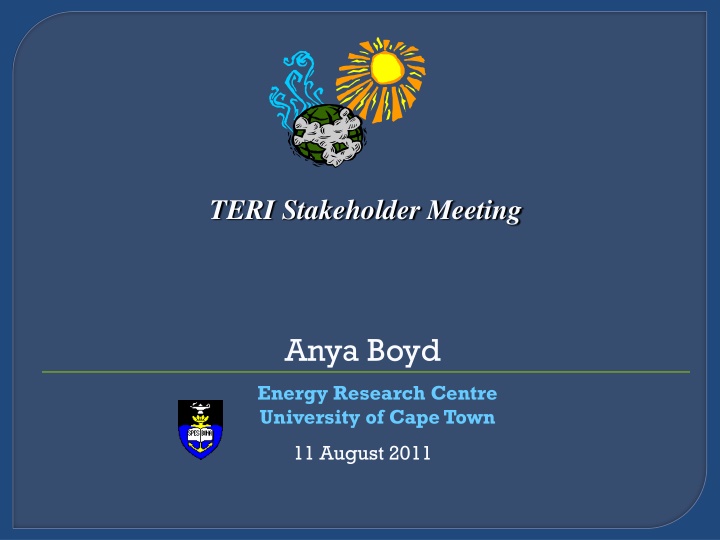
SA Climate & Energy Policy: Unpacking NAMA's and Mitigation Actions
South Africa's energy landscape and climate change challenges are explored in this stakeholder meeting presentation from the Energy Research Centre, University of Cape Town. The discussion delves into the country's high CO2 emissions, coal reliance, and initiatives towards a low carbon economy through NAMA implementation and mitigation strategies. Key topics include GHG inventories, renewable energy policies, and long-term mitigation scenarios.
Download Presentation

Please find below an Image/Link to download the presentation.
The content on the website is provided AS IS for your information and personal use only. It may not be sold, licensed, or shared on other websites without obtaining consent from the author. If you encounter any issues during the download, it is possible that the publisher has removed the file from their server.
You are allowed to download the files provided on this website for personal or commercial use, subject to the condition that they are used lawfully. All files are the property of their respective owners.
The content on the website is provided AS IS for your information and personal use only. It may not be sold, licensed, or shared on other websites without obtaining consent from the author.
E N D
Presentation Transcript
TERI Stakeholder Meeting Anya Boyd Energy Research Centre University of Cape Town 11 August 2011
SA Climate & Energy Policy SA Mitigation Unpacking & implementing NAMA s Other related work on NAMA s
Energy Research Centre 4 Different Groups Energy Environment & Climate Change Energy efficiency Energy modeling Energy Poverty & Development E.g. Academic, NGO, government
2000 GHG Inventory Energy Research Centre 5
SA highest CO2 emissions in African continent 96.2 Mt Ce (2007) 1.19% of global CO2 emissions, but high energy intensity makes it 44th (out of 185 countries) per capita emissions (CAIT 2011) Reliance on coal high energy intensity of the economy, 20th in the world (CAIT 2011) Coal provides 77% of primary energy needs (Eskom 2011) including 93% of electricity generation (IEA 2010)
National Climate Change Response (NCCR)- DEA Green Paper 2010 to White Paper REFIT- re-bid recently increased - DoE Carbon Tax discussion paper - NT Industrial Policy Action Plan (IPAP) DTI South African Renewable Initiative (SARi) Integrated Resource Plan (IRP) electricity generation DoE gazetted May 2011 Renewable Energy White Paper 2003 10, 000Gwh 2013 National Planning Commission (NPC) Low Carbon Economy
2006 2008 Long Term Mitigation Scenarios (LTMS) SA committed internationally under the CA to take nationally appropriate mitigation actions to enable a 34% deviation below Business as Usual emissions growth trajectory by 2020, and 42% by 2025 CDM activity minimal (<1%) Technical analysis of 4 potential NAMA s presented at Cancun not officially endorsed (available unfccc.int) CSP 5GW Wind 10GW NSSF Low cost housing Electric vehicles
Financing the inclusion of solar water heaters and thermal efficiency measures in one million new-build low-income houses by 2020 Description of NAMA GHG reductions from baseline (MtCO2eq) International support sought Indicators to track implementation of action Annual 3Mt 2011-2020 30Mt 2011-2030 95Mt Development of fund, programme and institutional capacity: 1m Capital costs of interventions: US$2.8 billion Number of new-build houses including upgrades Number of low-income housing solar water heaters remaining in operation in 2020/30 Significant health, safety and energy service delivery co-benefits through delivering improved quality housing to poor households Education and awareness-raising around clean energy issues in a sector of the population anticipated to drive emissions growth into the future Currently in advanced design phase, led by the Development Bank of Southern Africa Information which would add value
Technical Analysis of NAMAs at Cancun Mitigation Action Plans & Scenarios (MAPS) programme Mitigation actions in Latin American countries SA case study on approach to mitigation actions Bottom up/existing initiatives TERI project http://www.mapsprogramme.org/about/
Definitional issues How to compare/assess co-benefits/ SD vs. tCO2? What will MRV look like? What will the Registry look like? Difference to CDM? How to make it nationally appropriate?
Key Strategic Objectives Energy Research Centre 12 NPC Diagnostic Report 2011
Alignment to national priorities Potential conflict of interest Institutions & capacity to identify, design (modeling), implement & operationalise Domestic & international components Ownership and mandate Project specific blockages Indicators for tracking implementation
Sustainable development Add development implications Poverty component Co-benefits Implementation strategies Moving identified actions into projects Crediting NAMA s not focus More clarity of NAMA Learn from partners on approaches Energy Research Centre 14
Production and use of private passenger electric vehicles 10% penetration of electric private passenger vehicles by 2015, increasing to 27% in 2020, 60% expected by 2030 Description of NAMA GHG reductions from baseline (MtCO2 eq) 2011-2020 2011-2030 2011-2050 10.6 Mt 92.3 Mt 450.0 Mt Funding to cover incremental costs of US$344.7 billion from 2011-2050 to manufacture electric vehicles. It excludes costs for infrastructural reform. Technical support in establishing battery charging stations and battery swapping facilities. International support sought Sales of electric vehicles to assess take-up by consumers. Sales of petrol and diesel vehicles Sales volumes of petrol and diesel-displacement of vehicles that use these fuels. Indicators to track implementation of action Prototypes of wholly South African-designed electric vehicle models have been developed SA s Council for Scientific and Industrial Research has extensively researched lithium batteries; current studies are evaluating feasibility of developing and producing batteries locally Sustainable development benefits of the NAMA include lower local air pollution, employment creation and potential balance of payment benefits. Information which would add value
Production and use of private passenger electric vehicles 10% penetration of electric private passenger vehicles by 2015, increasing to 27% in 2020, 60% expected by 2030 Description of NAMA GHG reductions from baseline (MtCO2 eq) 2011-2020 2011-2030 2011-2050 10.6 Mt 92.3 Mt 450.0 Mt Funding to cover incremental costs of US$344.7 billion from 2011-2050 to manufacture electric vehicles. It excludes costs for infrastructural reform. Technical support in establishing battery charging stations and battery swapping facilities. International support sought Sales of electric vehicles to assess take-up by consumers. Sales of petrol and diesel vehicles Sales volumes of petrol and diesel-displacement of vehicles that use these fuels. Indicators to track implementation of action Prototypes of wholly South African-designed electric vehicle models have been developed SA s Council for Scientific and Industrial Research has extensively researched lithium batteries; current studies are evaluating feasibility of developing and producing batteries locally Sustainable development benefits of the NAMA include lower local air pollution, employment creation and potential balance of payment benefits. Information which would add value
Two phases: Prepare (2010-2012) and rollout (2013-2020) First plants coming into operation from 2015 and 5GW capacity online by 2020 Incorporate plan into IRP, conclude IPP/solar park regulatory framework and establish funding mechanism 2011-2020 2011-2030 232 Mt 663 Mt Finance $2 billion by 2020 as grant / concessional loan to the REFIT or Solar Park Technology initially parabolic trough, then CSP central receiver and dish designs. Water saving technology will become important Capacity REFIT & independent systems operator capacity support required Establishment of funding mechanisms - institutional Finance disbursed to utilities in CSP programme Capacity of CSP installed through programme Electricity produced from funded CSP installations Description of NAMA 2011-2050 1518 Mt GHG reductions from baseline (MtCO2eq) International support sought Indicators to track implementation of action Pioneering RE in electricity system, developing industrial capacity in CSP as a basis for further expansion Incremental employment benefits, especially with localisation Regional development, local air pollution benefits Information which would add value



